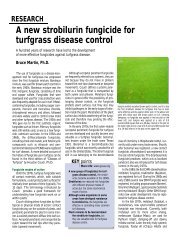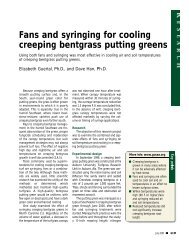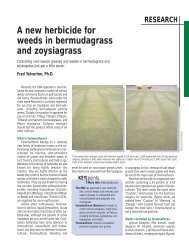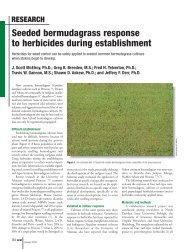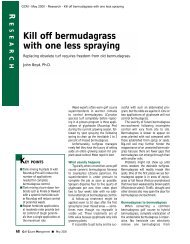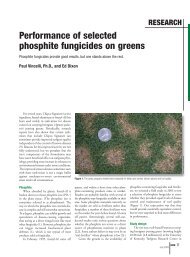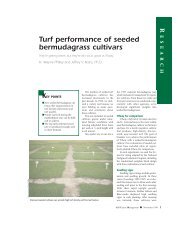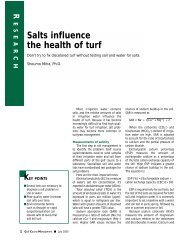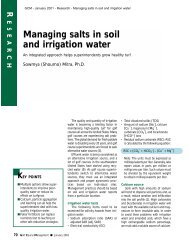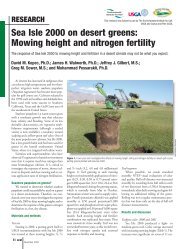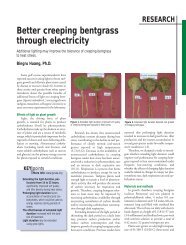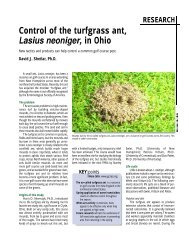Late-season bermudagrass nutrition and cold tolerance ... - GCSAA
Late-season bermudagrass nutrition and cold tolerance ... - GCSAA
Late-season bermudagrass nutrition and cold tolerance ... - GCSAA
- No tags were found...
Create successful ePaper yourself
Turn your PDF publications into a flip-book with our unique Google optimized e-Paper software.
081-092 Sept04Techwell 8/17/04 5:20 PM Page 82RESEARCHBefore we review this evidence, let’s frame thediscussion by reviewing <strong>bermudagrass</strong> growthduring the hardening period. Specifically, is itreasonable to think that lush shoot growthcan be promoted on transition zone<strong>bermudagrass</strong> (Cynodon species) once hardeningtemperatures are occurring? What arethese temperatures?When average daytime temperatures ([dailylow + daily high]/2) drop below 60 F (15.6 C),<strong>bermudagrass</strong> growth slows dramatically, withleaf discoloration (<strong>and</strong> the onset of dormancy)occurring in earnest once they drop below50 F (10 C) (5). In an upper transition zone climatesuch as in Roanoke, Va., average temperaturesof 60 F (15.6 C) are reached aroundSept. 30, with the first hard frost occurringabout Oct. 15, leading to almost complete leaftissue browning by early November.Thus, this mid-September to early-November hardening period is when textbooksadvise greatly reducing or actuallyeliminating the use of nitrogen. How does<strong>bermudagrass</strong> respond to the lower temperatures<strong>and</strong> shorter days of this period? Untilone or two hard frosts have occurred, the<strong>bermudagrass</strong> is still green <strong>and</strong> photosynthesizing,but little leaf elongation is occurring.But where is this photosynthate going?We contend that, as in cool-<strong>season</strong> grassesin late fall, most photosynthate is goingtoward root, stolon <strong>and</strong> rhizome growth orstorage. During this hardening period, itwould be almost impossible to promote alarge flush of succulent growth with an applicationof soluble nitrogen fertilizer. Try it, <strong>and</strong>the result is most often a greening responsewithout significant vertical growth.If the turf remains green later in the fall,the results should be greater photosynthesis<strong>and</strong> net energy gain. Loss of this re-greenedleaf tissue to a hard frost most likely has littleconsequence for overwintering becausethe status of the stem tissue (crowns, stolons<strong>and</strong> rhizomes) determines winter survival.Based on this reasoning, we hypothesizethat applying nitrogen late in the <strong>season</strong> inthe transition zone on <strong>bermudagrass</strong> that hasnot been overseeded will:• enhance color retention before frost events• encourage re-greening after mild frostevents• have no effect on <strong>cold</strong> hardiness• promote early spring green-upBelow we present supporting data fromfour late-<strong>season</strong> nitrogen studies conductedover the last 15 years.Study 1: Schmidt <strong>and</strong> ChalmersAt the Virginia Tech Turfgrass ResearchCenter in Blacksburg, mature Tifgreen<strong>bermudagrass</strong> was managed at 0.625 inch(15.88 millimeters) on a silt loam (pH 6.2<strong>and</strong> moderately high soil-test level of potassiumat 274 pounds/acre [307.1 kilograms/hectare]).[Researchers (5) havepresented the following potassium sufficiencyrankings: very low = 0-60 pounds/acre (0-67.3 kilograms/hectare); low = 61-120pounds/acre (67.3-134.5 kilograms/hectare);moderate = 121-280 pounds/acre (135.6-313.8 kilograms/hectare); high = greater than280 pounds/acre (313.8 kilograms/hectare).]The <strong>bermudagrass</strong> was treated with 0, 2.5pounds or 5.0 pounds nitrogen/1,000 squarefeet (0, 122.1 or 244.1 kilograms/hectare)from urea in split applications on Aug. 30<strong>and</strong> Sept. 27 of 1989, 1990 <strong>and</strong> 1991.The results in Table 1 clearly show thatlate-summer through early-fall nitrogenapplications to Tifgreen <strong>bermudagrass</strong>, amoderately winter-hardy cultivar, providedextended color in fall 1989. Similar resultswere found in 1990 <strong>and</strong> 1991. At no timeduring the three years of the study was<strong>bermudagrass</strong> recovery from dormancyimpaired because of late-<strong>season</strong> nitrogen(13). This was true even though conditionsin December 1989 were unusually <strong>cold</strong>,with a record low for Dec. 23 of -10 F(-23.3 C). Temperatures were normal inBlacksburg, Va., during the winters of 1990-1991 <strong>and</strong> 1991-1992.Study 2: Goatley et al.Mature Tifgreen <strong>bermudagrass</strong>, managedat 0.18 inch (4.57 millimeters) on aloam (pH 6.0 <strong>and</strong> a high soil-test level ofpotassium of 300 pounds/acre [336.3kilograms/hectare]) in Starkville, Miss.,received 0, 1.0 or 2.0 pounds nitrogen/1,000 square feet (0, 48.8 or 97.6 kilograms/hectare)from ammonium nitrate<strong>and</strong> 0, 0.8 or 2.0 pounds potassium (0, 39.1or 97.6 kilograms/hectare) from potassiumchloride (in all combinations) during the secondweek of October in 1989, 1990 <strong>and</strong>1991. On this soil, which contained sufficientsoil-available potassium (5), fertilizingwith potassium did not measurably change<strong>bermudagrass</strong> color or levels of total nonstructuralcarbohydrate (TNC) at any timefor any level.LATE NITROGEN ON TIFGREENNitrogen application rate 1989 color rating (9 = darkest) % greenhouse regrowth*Pounds/1,000 sq. ft. Kilograms/hectare Oct. 3 Oct. 16 Oct. 23 Feb. 15, 1990Control (no nitrogen applied) 5.8 b 4.4 b 4.3 c 28.6 a2.5 122.1 7.2 a 5.3 a 4.9 b 24.7 a5.0 244.1 7.3 a 5.3 a 6.3 a 26.1 a*Percentage of greenhouse regrowth of dormant plugs that are subjected to controlled freezing to 23 F (-5 C). Plugs were sampled <strong>and</strong> frozen on Jan. 25, 1989.Table 1. Influence of 1989 late-summer <strong>and</strong> early-fall applications of nitrogen on fall color <strong>and</strong> <strong>cold</strong> hardiness of Tifgreen <strong>bermudagrass</strong>.Values followed by the same letters within a column are not significantly different from each other.82 GCMSeptember 2004



